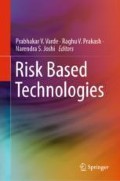Abstract
Human reliability analysis is a discipline that focuses on understanding and assessing human behavior during its interactions with complex engineered systems. Central to the discipline are human reliability models and data collection efforts. This paper briefly reviews the state of the art in human reliability analysis and evaluates it against a set of criteria that can be established when it is viewed as a science.
Access this chapter
Tax calculation will be finalised at checkout
Purchases are for personal use only
References
Boring, R. L., Hendrickson, S. M., Forester, J. A., Tran, T. Q., & Lois, E. (2010). Issues in benchmarking human reliability analysis methods: A literature review. Reliability Engineering & System Safety., 95(6), 591–605.
Boring, R., Kelly, D., Smidts, C., Mosleh, A., & Dyre, B. (2012, June 25) Microworlds, simulators, and simulation: Framework for a benchmark of human reliability data sources. In Joint probabilistic safety assessment and management and european safety and reliability conference, 16B-Tu5-5.
Cacciabue, P. C., Decortis, F., Drozdowicz, B., Masson, M., & Nordvik, J. P. (1992). COSIMO: A cognitive simulation model of human decision making and behavior in accident management of complex plants. IEEE Transactions on Systems, Man, and Cybernetics, 22(5), 1058–1074.
https://dictionary.cambridge.org/us/dictionary/english/understanding/. Retrieved September 2018.
Chang, Y. H. J., & Mosleh, A. (2007). Cognitive modeling and dynamic probabilistic simulation of operating crew response to complex system accidents: Part 1: Overview of the IDAC Model. Reliability Engineering & System Safety, 92(8), pp. 997–1013.
Chang, Y. J., Bley, D., Criscione, L., Kirwan, B., Mosleh, A., Madary, T., et al. (2014). The SACADA database for human reliability and human performance. Reliability Engineering & System Safety, 125, 117–133.
Embrey, D. E., Humphreys, P., Rosa, E. A., Kirwan, B. & Rea, K. (1984). SLIM-MAUD: An approach to assessing human error probabilities using structured expert judgment. Volume II. Detailed analysis of the technical issues (No. NUREG/CR–3518-VOL. 2). Brookhaven National Laboratory.
Kurtoglu, T., Tumer, I. Y. & Jensen, D. C. (2010). A functional failure reasoning methodology for evaluation of conceptual system architectures. Research in Engineering Design, 21(4), 209–234.
Lois, E., Dang, V. N., Forester, J., Broberg, H., Massaiu, S., Hildebrandt, M. et al. (2008). International HRA Empirical Study–Description of overall approach and first pilot results from comparing HRA methods to simulator data. Halden Work Report HWR-844, Rev, 1.
Mutha, C., Jensen, D., Tumer, I., & Smidts, C. (2013). An integrated multidomain functional failure and propagation analysis approach for safe system design. AI EDAM, 27(4), 317–347.
Poucet, A. (1988). Survey of methods used to assess human reliability in the human factors reliability benchmark exercise. Reliability Engineering & System Safety., 22(1–4), 257–268.
Ratcliff, R., & Smith, P. L. (2004). A comparison of sequential sampling models for two-choice reaction time. Psychological Review, 111(2), 333.
Rumbaugh, J., Jacobson, I. & Booch, G. (2004). Unified modeling language reference manual (2nd ed.). Pearson Higher Education.
Science Council. https://sciencecouncil.org/about-science/our-definition-of-science/. Retrieved in 2018.
Shirley, R. B., Smidts, C., Li, M., & Gupta, A. (2015). Validating THERP: Assessing the scope of a full-scale validation of the technique for human error rate prediction. Annals of Nuclear Energy, 77, 194–211.
Shirley, R. B. & Smidts, C. (2018). Bridging the simulator gap: Measuring motivational bias in digital nuclear power plant environments. Reliability Engineering & System Safety.
Smidts, C., Shen, S. H., & Mosleh, A. (1997). The IDA cognitive model for the analysis of nuclear power plant operator response under accident conditions. Part I: Problem solving and decision making model. Reliability Engineering & System Safety, 55(1), 51–71.
Spurgin, A. J. (1990). Operator reliability experiments using power plant simulators, volume 1: executive summary. Electric Power Research Institute.
Swain, A. D. & Guttmann, H. E., 1983. Handbook of human-reliability analysis with emphasis on nuclear power plant applications. Final report (No. NUREG/CR-1278; SAND-80-0200). Albuquerque, NM (USA): Sandia National Labs.
US Nuclear Regulatory Commission. Licensee Event Report (LER). https://www.nrc.gov/reading-rm/doc-collections/event-status/. Retrieved in 2018.
https://www.merriam-webster.com/dictionary/understanding/. Retrieved in 2018.
Woods, D. D., PopleJr, H. E., & Roth, E. M. (1992). Cognitive environment simulation: A tool for modeling intention formation for human reliability analysis. Nuclear Engineering and Design, 134(2–3), 371–380.
Zhao, Y. & Smidts, C. (2017, July). A dynamic mechanistic model of human response proposed for human reliability analysis. In International conference on applied human factors and ergonomics (pp. 261–270). Springer, Cham.
Acknowledgements
I wish to acknowledge Yunfei Zhao for his comments on this document and for his editorial support.
Author information
Authors and Affiliations
Corresponding author
Editor information
Editors and Affiliations
Rights and permissions
Copyright information
© 2019 Springer Nature Singapore Pte Ltd.
About this chapter
Cite this chapter
Smidts, C. (2019). Human Reliability as a Science—A Divergence on Models. In: Varde, P., Prakash, R., Joshi, N. (eds) Risk Based Technologies. Springer, Singapore. https://doi.org/10.1007/978-981-13-5796-1_8
Download citation
DOI: https://doi.org/10.1007/978-981-13-5796-1_8
Published:
Publisher Name: Springer, Singapore
Print ISBN: 978-981-13-5795-4
Online ISBN: 978-981-13-5796-1
eBook Packages: EngineeringEngineering (R0)

